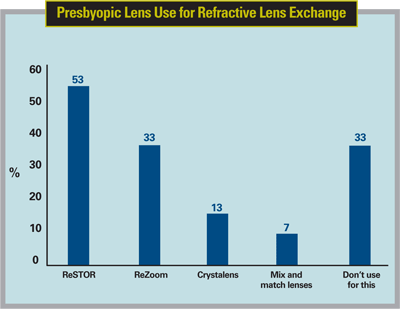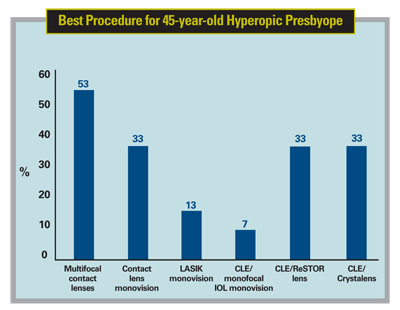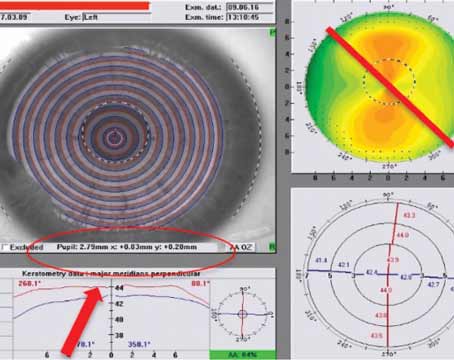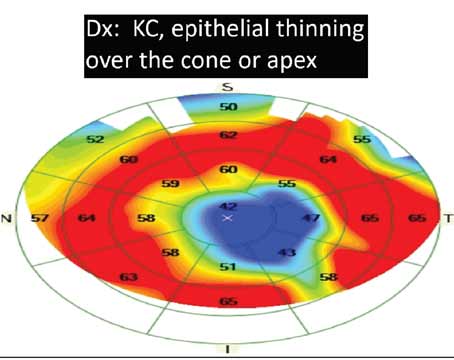LASIK remains the most popular refractive procedure, but concern about potential ectasia in patients with unusual corneal topographies or borderline corneal thicknesses, however, is changing the way many surgeons approach surgical candidates.
This month's National Panel Report addressed refractive surgery issues. Thirty surgeons, or 6 percent of our 500-surgeon sample, responded. Here's what they had to say.
LASIK Spotlight
LASIK continues to be the most popular surgical option among our panelists, with 83 percent of the respondents who perform refractive surgery saying they do conventional and/or custom LASIK. Their preferred procedure for the majority of their cases is custom LASIK for 73 percent of the panel; 17 percent like PRK and 10 percent choose conventional LASIK. Among surgeons who perform surface ablation procedures, 77 percent use the antifibrotic agent mitomycin-C prophylactically to stave off haze and regression.
On average, most of the respondents (86 percent) say they perform between five and 20 LASIK cases each month. Seven percent perform 51 to 75 cases and another 7 percent do 76 to 100 cases. They charge an average of $2,454 per eye for LASIK, and have to deal with an average facility fee of $795. If they offer custom LASIK, they usually increase the price an average of $109 over conventional LASIK.
When it comes to making their LASIK flaps, 43 percent say they use the IntraLase femtosecond laser. The average flap thickness of all the LASIK surgeons is 130 µm.
"I like the IntraLase," says a surgeon from
"The IntraLase gives excellent, smooth flaps," says
Ectasia Concerns
Eighty-three percent of the respondents say the threat of ectasia has affected the way they approach LASIK candidates, raising their index of suspicion. "If the corneal thickness is less than a certain level, I won't make a flap," avers Dr. Decker. "I'll advise the patient to have surface ablation."

A doctor from
"I'm going to PRK more readily for patients with funny topography," says a surgeon from
An

Preferred Procedures
Surgeons were also asked how they would approach patients with certain refractive errors. Here's how they responded for the various patient presentations:
• -3 D myope. As one might expect, custom LASIK was the most popular choice for this type of patient, and was chosen by 70 percent of the respondents. Thirteen percent chose conventional LASIK and 13 percent preferred PRK. "Custom LASIK is low risk for this patient," says a surgeon from
Douglas Liva, MD, of
A
• -6 D myope. For this level of correction, both custom LASIK and surface ablation become a little more popular. Almost three-quarters of the surgeons say they'd choose custom LASIK, 17 percent like PRK and 7 percent would stick with conventional LASIK.
"I believe custom's results are excellent," says Dr. Liva.
• -11 D myope. Once the error gets this high, 77 percent of the surgeons say the best procedure is probably a phakic intraocular lens. Thirteen percent think clear-lens extraction/IOL implantation is the way to go, and 10 percent think LASIK is an option.
"A phakic intraocular lens would induce less optical aberration," says a surgeon from
A surgeon from
New Jersey
• +2 D hyperope. For this patient, 83 percent say that LASIK would be the best procedure if the patient were young (younger than around 50), while 6 percent think PRK could do it for a younger patient, and 10 percent fall on the side of a clear lens extraction procedure, especially if the patient were older than 50. "It definitely depends on age," says a physician from
• 45-year-old myopic presbyope. For this patient, 30 percent of the respondents who answered the question think bifocals are best, 30 percent prefer LASIK monovision, 20 percent like contact-lens monovision, 10 percent say conductive keratoplasty is useful and 10 percent think the Crystalens is best.
"I offer contact-lens monovision, bifocals and multifocal contact lenses," says Dr. Liva. "I don't feel the results of any of the presbyopic IOLs are good enough to offer them for CLE/IOL."
A 
"Multifocal IOLs cannot compete with the clarity of a clear crystalline lens," says a surgeon from
• 45-year-old hyperopic presbyope. For this particular patient presentation, 20 percent of respondents prefer contact-lens monovision, 20 percent like CLE/implantation of a monovision IOL, 20 percent think CLE/ReSTOR lens implantation is best, a fifth think LASIK monovision would be preferable, 10 percent say multifocal contact lenses are the best option and 10 percent like CLE/Crystalens implantation.
"For +1 D to +2.5 D, I'd prefer LASIK," says an
"In the absence of cataract, I have difficulty offering multifocal lenses to a patient," says a





